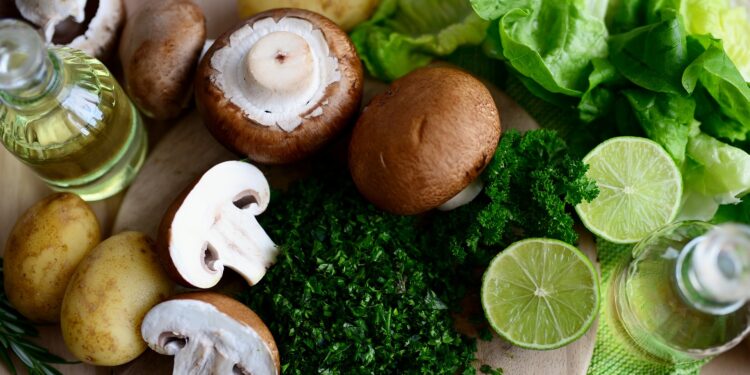Ingredients commonly used in cooking
0
SHARES
22
VIEWS
Let’s explore some common ingredients used in cooking along with their characteristics and how to make the most out of them:
- Garlic:
- Flavor Profile: Garlic has a pungent, spicy-sweet flavor when raw. When cooked, it mellows into a sweeter, nutty flavor.
- Nutritional Benefits: Garlic is low in calories but rich in vitamin C, vitamin B6, and manganese. It also contains sulfur compounds with potential health benefits.
- Storage Tips: Store garlic bulbs in a cool, dark, dry place with good ventilation. Avoid storing them in the refrigerator, as it can cause them to sprout.
- Creative Uses: Use minced or sliced garlic in stir-fries, pasta sauces, marinades, and salad dressings. Roasted garlic adds a sweet, caramelized flavor to dishes like mashed potatoes or spread on bread.
- Olive Oil:
- Flavor Profile: Olive oil has a fruity, grassy flavor with peppery notes, varying based on the type and quality.
- Nutritional Benefits: It’s rich in monounsaturated fats, antioxidants like vitamin E, and anti-inflammatory compounds. Regular consumption is associated with various health benefits.
- Storage Tips: Store olive oil in a cool, dark place away from heat and light to prevent oxidation. Use it within a few months of opening for optimal flavor.
- Creative Uses: Use olive oil in salad dressings, for sautéing vegetables, drizzling over roasted meats or vegetables, or as a dip for bread. Infuse olive oil with herbs or spices for added flavor.
- Onions:
- Flavor Profile: Onions have a sharp, pungent flavor when raw, which becomes sweet and savory when cooked.
- Nutritional Benefits: Onions are low in calories but rich in antioxidants, vitamins C and B6, and dietary fiber. They also contain sulfur compounds with potential health benefits.
- Storage Tips: Store onions in a cool, dry, well-ventilated place away from potatoes. Avoid storing them in the refrigerator, as they can become mushy.
- Creative Uses: Use raw onions in salads, sandwiches, or as a garnish. Cooked onions add depth of flavor to soups, stews, sauces, and stir-fries. Caramelize onions for a sweet, rich topping for burgers, pizzas, or tarts.
- Tomatoes:
- Flavor Profile: Tomatoes have a sweet, tangy flavor with a hint of acidity and umami when ripe.
- Nutritional Benefits: They are rich in vitamin C, potassium, folate, and antioxidants like lycopene, which is associated with various health benefits.
- Storage Tips: Store ripe tomatoes at room temperature away from direct sunlight. Refrigeration can dull their flavor and texture, so use them within a few days.
- Creative Uses: Use fresh tomatoes in salads, sandwiches, or bruschetta. Cooked tomatoes are excellent in sauces, soups, stews, and braises. Roast tomatoes for a concentrated flavor to use in pasta dishes or as a side dish.
- Basil:
- Flavor Profile: Basil has a sweet, peppery flavor with hints of clove and mint.
- Nutritional Benefits: Basil is low in calories but rich in vitamin K, vitamin A, and antioxidants. It also contains essential oils with potential health benefits.
- Storage Tips: Store fresh basil at room temperature in a glass of water, like flowers. Alternatively, wrap it in a damp paper towel and place it in a plastic bag in the refrigerator.
- Creative Uses: Add fresh basil leaves to salads, sandwiches, or pizza. Use it to make pesto sauce, stir it into soups or sauces just before serving, or infuse it into oils or vinegar for added flavor.
These are just a few examples of versatile ingredients commonly used in cooking. Experimenting with different combinations and cooking techniques can unlock a world of flavors in your dishes!
You need to login or register to bookmark/favorite this content.
Please login to join discussion
No Result
View All Result
Categories
- * Blog (8)
- * Recipes (85)
- Air fryer (1)
- Appetizers (9)
- Breakfast (9)
- Desserts (12)
- Fish & Seafood (9)
- Main Course (18)
- Salads (9)
- Sauces And Dressings (10)
- Slow cooker (9)
- Soups (14)
- Spice blend (8)
Product categories
- Clothing (4)
- eBooks (5)
- Kitchen (1)
- Membership (3)
- Promotional items (2)
Converter
Recent Recipes
Strawberry Crumble
30/04/2025
Burger sauce
30/10/2024
















